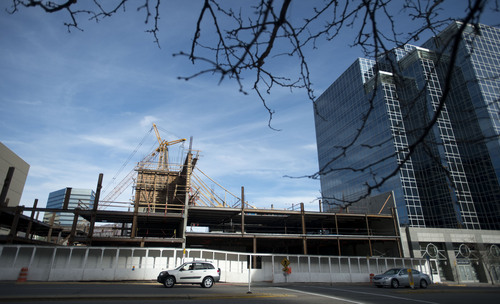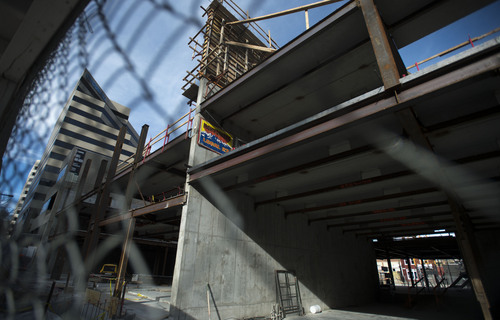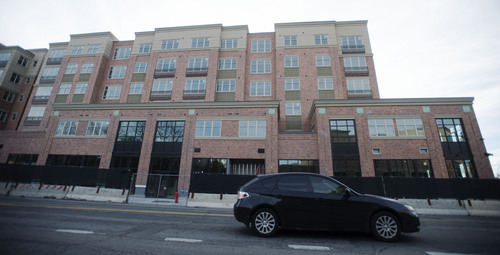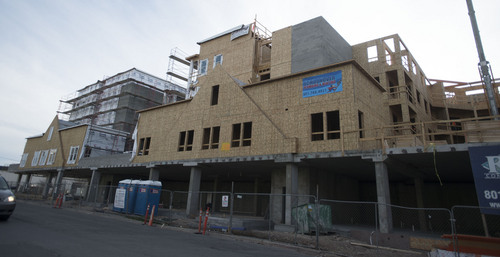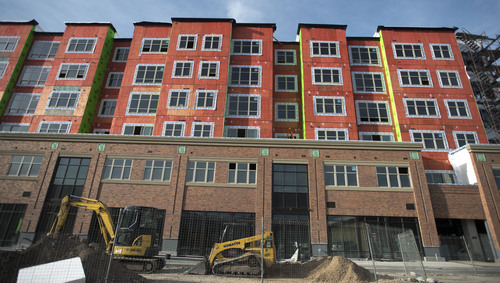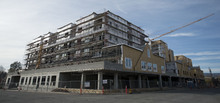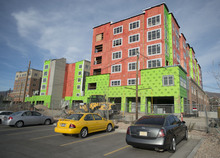This is an archived article that was published on sltrib.com in 2014, and information in the article may be outdated. It is provided only for personal research purposes and may not be reprinted.
As Utah's economy recovers, competing sectors of the housing industry are betting heavily on how to meet future home needs. Record numbers of urban apartments are being built across Salt Lake County, just as home construction gears up to feed demand for single-family suburban houses.
Can both gambles succeed?
Real-estate agents, bankers and some homebuilders are steadfastly optimistic about single-family home sales, with interest rates at historic lows and prices in Utah markets finally bouncing back from a six-year downturn. Their cheerfulness is buoyed by a nearly 6 percent gain in home sales for 2013 over the year before in Salt Lake County and similar rises across the Wasatch Front.
"It makes perfect financial sense to purchase a home," Dave Robison, president-elect of the Salt Lake Board of Realtors, told fellow real-estate agents in a recent upbeat video posted on YouTube. "Now is the time to start looking, especially in the Salt Lake area."
Following last summer's home price surge, builders are putting up thousands of new homes, centered on suburban pockets of the Wasatch Front. Firming up their confidence: Utah's steady population increases and continued in-migration to the state in reaction to its healthy job growth.
Housing starts — a measure of new homes now being built — were up 20 percent at year's end over 2011 levels for Utah's most populous county, with even higher gains in south county cities such as Bluffdale, Draper and Sandy. Elsewhere, the latest numbers from the research firm Metrostudy show Utah, Davis, Tooele, Weber, Wasatch and Summit counties all saw housing-start increases as 2013 came to a close, in anticipation of 2014 sales.
Anecdotally, some Realtors say the past few weeks of warmer weather brought buyers out in large numbers and that inventories of available homes already seem tight, even before the 2014 sales season kicks into full swing.
"It's insane," said Babs De Lay, a broker with Urban Utah Homes and Estates, which specializes in Salt Lake City homes. "I cannot find a livable home under $300,000 that isn't sold in a day within city limits."
But other numbers hint that a full and sustained return to single-family home sales volumes seen before the housing crash could be years away.
—
A shifting American dream • A shattering of the prevailing belief that home prices always rise is combining with an increasing tendency to delay marriage and starting a family to turn a generation away from homeownership, a prominent Utah homebuilder says.
"Those two trends have created a permanent change," predicts Colin Wright, CEO of Henry Walker Homes. "We've lost a generation, call them the 28- to 38-year-olds. They're permanently scarred."
Key metrics point to the same conclusion.
With its cultural emphasis on family, Utah has traditionally ranked among the highest U.S. states for homeownership. Yet recently that rate has plunged in the Beehive State, from 76.2 in 2008 to 70.9 last year, according to U.S. Census Bureau statistics.
On both state and national levels, the downward trend is even more stark for those on the cusp of forming their own households, in the key age groups between 25 and 34 years old.
Some of the decline is driven by hard numbers.
Incomes have not kept pace with home-price gains in recent years, pushing affordability out of reach for some entry-level homebuyers. In Salt Lake County, home prices rose 15.6 percent last year. While that was good news for homeowners, the ratio of prices to incomes for those starting out is now above its historic average. That's been made more pronounced by shrinking supplies of lower-priced homes along the Wasatch Front.
Interest rates are another factor. Rates on traditional fixed-rate 30-year mortgages rose to 4.48 percent from 3.35 percent over the course of last year, pushing average mortgage payments up by as much as a third, according to data from the government mortgage agency Freddie Mac.
Overall lending standards also have tightened since the crash, particularly for public home-loan insurers such as the Federal Housing Administration, often a crucial means for first-time buyers to afford a mortgage.
"The big thing is more paperwork, more documentation," said Randell Gillespie, senior vice president for Bank of America whose region of responsibility includes Salt Lake City. "Most consumers know that but more in a fearful way. Most of the time, though, it's more of a misunderstanding about what it takes for homeownership."
—
Lifestyle renters • Longer-term demographics are also at play, leading large numbers of investors to pour cash into rental properties and developments in Utah markets.
Changing career patterns, a desire for more mobility, preferences for urban living and wariness of mortgage debt are all creating an emerging class of lifestyle renters, who are rejecting homeownership in favor of the ease and flexibility of renting.
Brokers tell of daily calls from out-of-state investors clamoring for downtown sites for multifamily construction. When one key urban lot along the TRAX red line near 400 South and 700 East in Salt Lake City went up for sale recently, it drew sizable bids from 17 prospective buyers, nearly half based outside Utah. Sixteen of the bidders want the site for apartments.
Apartment developers already are bringing a record number of new dwellings to market in and around Salt Lake City in a kind of boom in multifamily units, particularly downtown.
They've been spurred by falling vacancy rates for apartments, which, according to the U.S. Census Bureau, closed 2013 at around 6.7 percent statewide, down from 8.3 percent just five years ago. Local analysts say the number has dipped as low as 5 percent in recent months.
At least 3,274 apartments are under construction across Salt Lake County and another 5,674 have been proposed for this year, according to EquiMark, which tracks Utah's multifamily-housing markets. In downtown Salt Lake City alone, one analyst said, nearly twice as many apartments are proposed or being built now as were constructed in the prior decade.
"The pipeline of new construction keeps growing," said Sage Sawyer, a principal broker at EquiMark. The trend, he said, has the potential to glut apartment markets during the next two to three years.
While that could be advantageous for renters with more landlords competing for their business, it may disappoint investors who planned on vacancy rates to stay low in the near term and continued upward pressure on monthly rents.
"If everything that is proposed gets built," Sawyer said, "there is definitely going to be some softness in the market."
tsemerad@sltrib.com Twitter: @Tony_Semera —
Key Numbers on Utah Home Markets
Homeownership percentage:
2008 2013 Change
Utah 76.2 70.9 -5.3% U.S. 69.6 67.1 -2.5%
Rental vacancy percentage:
2008 2013 Change
Utah 7.5 6.7 -0.8% U.S. 9.7 8.4 -1.3%
Source: U.S. Census Bureau Housing Survey


